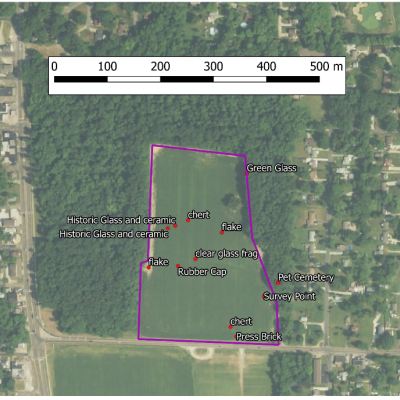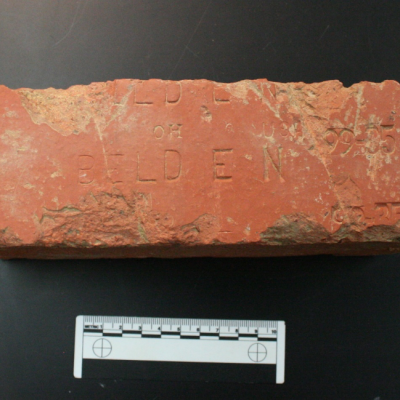In late 2017, SHiP conducted a pedestrian survey of an 18-acre portion of the Interval Brotherhood Home property. The project area consisted of 18 acres of plowed cornfield. The goal of the investigations was to identify potential archaeological sites within the survey area. A total of 17 transects were walked north to south in the survey area, spaced 15 meters apart. These fields, located near Portage Lakes, had not been previously surveyed for archaeological materials. This project provided an opportunity for students at the University of Akron Department of Anthropology to gain first-hand experience in surface survey, which is a common form of archaeological reconnaissance survey.
Out of the 17 transects walked, six were positive for cultural materials. Of the six positive transects, two of them were historic scatters that likely represent redeposited trash to fill the numerous rodent holes throughout the field. There were other materials scattered throughout the field, including clear bottle glass, rubber agricultural caps from machinery and equipment, and other plastic debris. These debris were likely the result of errant drops from farm equipment, and the trash from the wooded patch in the northeast. The wooded patch was littered with beer cans and bottles, wood planks, aluminum snack bags, and other trash likely associated with the campfire in the center of the wooded patch. Two golf balls were found north and south of the wooded patch at either end of the field, indicating that they may have been driven from the wooded patch to either end of the field as part of the various “recreation” that occurred in the wooded patch of the field.
The prehistoric materials consisted of two flakes and an expedient scraper. One of the flakes is a whitish piece of glacial chert common to Northeast Ohio; the other flake is likely a lower quality of Upper Mercer common to southwestern Summit County and Stark County, though the material could also be glacial chert. The scrapper is made of glacial chert, with a majority of the dorsal surface covered in cortex. The scraper is also very small and does not have any evidence of hafting. Based on these observations, the scraper was likely an expedient tool used in the processing of a small hide, or perhaps a few plant fibers. Two other chunks of chert were collected in the field and plotted, but these chert chunks were likely not culturally modified, though they were large enough (10+ grams) to be worked.
The historic materials used for rodent hole fill consisted of clear window glass, porcelain, and ceramics. One piece of aqua blue glass, the bottom of a bottle or more likely mason jar, was found northwest of the wooded patch. A single, mostly intact brick was recovered five meters north of the fence. The brick is a pressed brick, common of the late 19th century through the 1920s, with the stamp “Belden OH 99-35.” The brick was manufactured by the Belden Brick Company, likely between 1895 and 1935, when pressed bricks were manufactured by the company en masse. The proximity to the road, the stamp, and the lack of holes indicate that the brick was a paving brick likely used as one of the original pavers for Killian Road. Other asphalt and gravel was observed near the brick, which supports this interpretation.
One archaeological site, 33 SU 683, was discovered during survey of the IBH property. The site is a small historic and prehistoric surface scatter that has been disturbed by plowing or redeposited from other contexts. Based on this evidence, 33 SU 683 does not have the potential to yield significant new data about the past, and there is no ability to associate the site with a significant historic era, event, person, or architectural or stylistic type.




